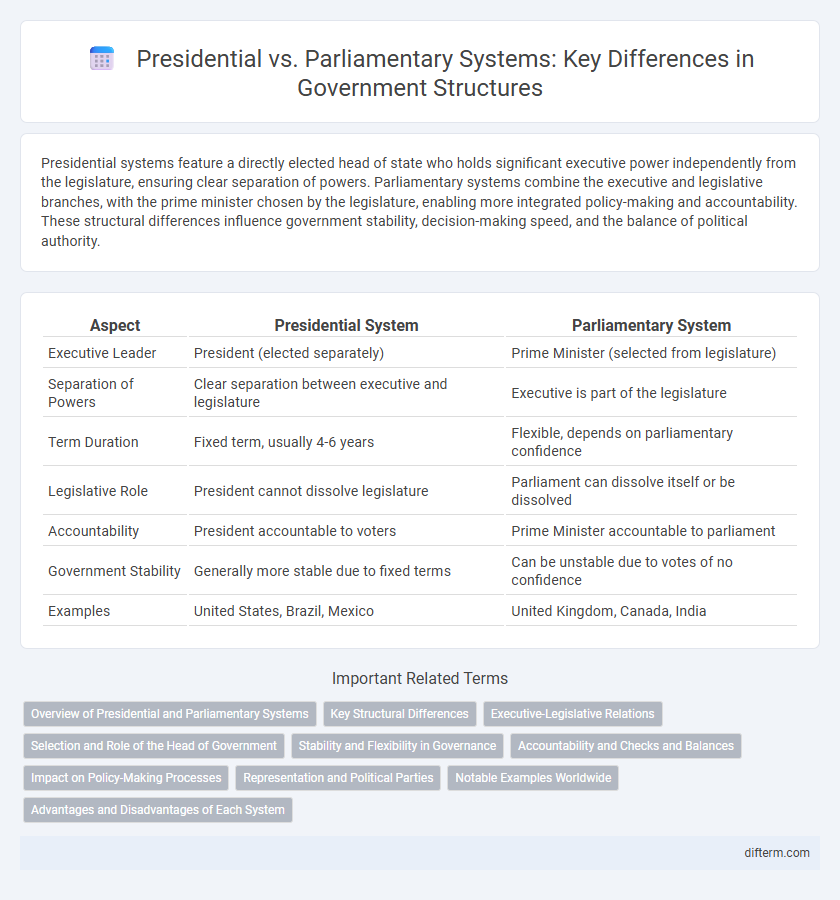Presidential systems feature a directly elected head of state who holds significant executive power independently from the legislature, ensuring clear separation of powers. Parliamentary systems combine the executive and legislative branches, with the prime minister chosen by the legislature, enabling more integrated policy-making and accountability. These structural differences influence government stability, decision-making speed, and the balance of political authority.
Table of Comparison
| Aspect | Presidential System | Parliamentary System |
|---|---|---|
| Executive Leader | President (elected separately) | Prime Minister (selected from legislature) |
| Separation of Powers | Clear separation between executive and legislature | Executive is part of the legislature |
| Term Duration | Fixed term, usually 4-6 years | Flexible, depends on parliamentary confidence |
| Legislative Role | President cannot dissolve legislature | Parliament can dissolve itself or be dissolved |
| Accountability | President accountable to voters | Prime Minister accountable to parliament |
| Government Stability | Generally more stable due to fixed terms | Can be unstable due to votes of no confidence |
| Examples | United States, Brazil, Mexico | United Kingdom, Canada, India |
Overview of Presidential and Parliamentary Systems
Presidential systems feature a separately elected executive president who holds significant authority independently from the legislature, promoting a clear separation of powers. Parliamentary systems, conversely, rely on a fusion of executive and legislative branches, where the prime minister and cabinet are drawn from the legislature and remain accountable to it. Both systems shape governance structures, political stability, and the balance of power in distinct ways within democratic governments.
Key Structural Differences
Presidential systems feature a clear separation of powers with an independently elected president serving as both head of state and government, ensuring direct executive authority. Parliamentary systems integrate the executive and legislative branches, where the prime minister is typically chosen from the majority party in the legislature and remains accountable to it. This structural difference affects executive stability, legislative oversight, and the efficiency of policy implementation in governance.
Executive-Legislative Relations
Presidential systems feature a clear separation of powers, where the executive and legislature are elected independently, leading to potential checks and balances but also gridlock. Parliamentary systems integrate the executive within the legislature, with the prime minister typically drawn from the majority party, fostering greater policy cohesion and faster decision-making. This fusion of powers often allows for more coordinated executive-legislative relations, though it may reduce legislative independence compared to presidential regimes.
Selection and Role of the Head of Government
The presidential system features a head of government directly elected by citizens, serving as both the executive leader and head of state, ensuring a fixed term and independent authority. In contrast, the parliamentary system selects the head of government from the majority party or coalition within the legislature, typically the prime minister, who depends on legislative confidence to remain in office. This distinction affects the concentration of power, accountability mechanisms, and the stability of executive leadership in governance structures.
Stability and Flexibility in Governance
Presidential systems offer greater stability through fixed terms and clear separation of powers, reducing the risk of abrupt government changes. Parliamentary systems provide flexibility, enabling swift government reformation via votes of confidence and coalition adjustments. Stability in presidential governance supports long-term policy consistency, while parliamentary flexibility allows adaptation to shifting political landscapes.
Accountability and Checks and Balances
Presidential systems centralize executive authority in a directly elected president, enhancing clear accountability but often resulting in weaker legislative oversight. Parliamentary systems distribute power between the prime minister and legislature, fostering stronger checks and balances through collective responsibility and parliamentary confidence votes. Effective accountability mechanisms vary, with presidential regimes relying on separation of powers and parliamentary regimes leveraging fusion of powers to ensure government responsiveness.
Impact on Policy-Making Processes
Presidential systems centralize executive authority in a single elected president, accelerating decision-making but risking policy gridlock during divided government. Parliamentary systems link executive power to legislative majorities, fostering policy coherence and swift legislative approval though potentially reducing executive stability. The impact on policy-making hinges on the balance between efficiency in enacting laws and maintaining representative accountability within each system.
Representation and Political Parties
Presidential systems feature distinct separation of powers, where the president is directly elected and represents the entire nation independently from the legislature, often leading to a stable two-party dominance. In contrast, parliamentary systems integrate executive and legislative functions, with the government formed by the majority party or coalition in parliament, promoting multiparty collaboration and more proportional representation. Political parties in parliamentary regimes typically hold greater influence over policy-making and leadership selection, enhancing representation of diverse interests within the legislature.
Notable Examples Worldwide
The United States exemplifies a presidential system where the president serves as both head of state and government, elected independently of the legislature. In contrast, the United Kingdom operates a parliamentary system with a prime minister as head of government, while the monarch remains the ceremonial head of state. Countries like Germany and India showcase hybrid parliamentary frameworks combining federal structures with parliamentary governance.
Advantages and Disadvantages of Each System
Presidential systems offer clear separation of powers, promoting stability through fixed terms and direct electoral mandates, but risk gridlock due to potential conflicts between executive and legislative branches. Parliamentary systems enable greater legislative-executive integration, fostering swift policy-making and government accountability, though they may suffer from instability through frequent votes of no confidence and coalition fragility. Both systems present distinct governance trade-offs impacting democratic representation, political efficiency, and institutional resilience.
presidential vs parliamentary Infographic

 difterm.com
difterm.com